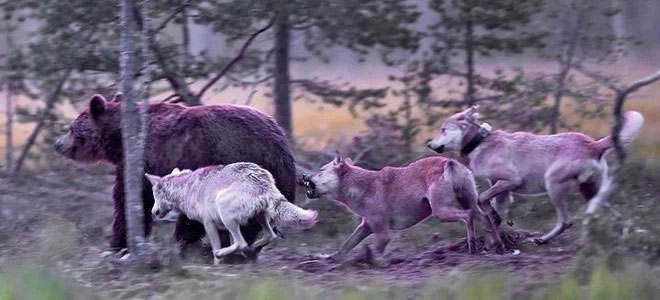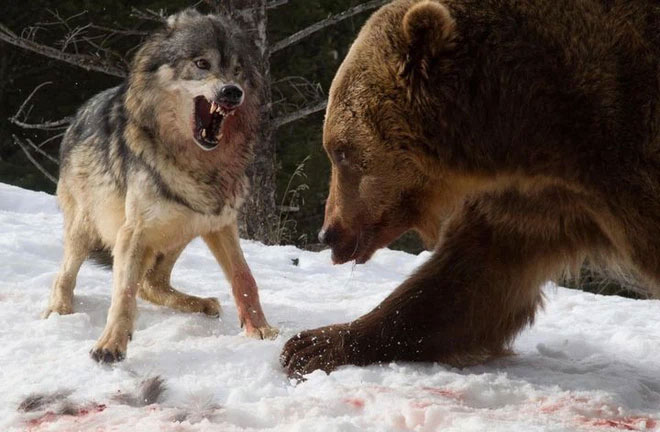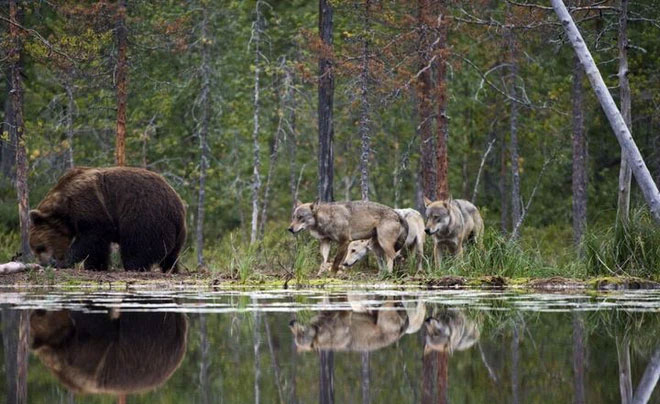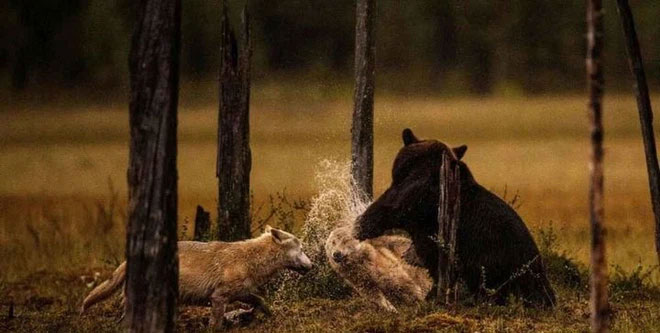Last winter was unusually warm, which caused some brown bears to delay their hibernation until January. One brown bear was resting under a large cedar tree in the forest when it was spotted by five wolves passing by, who immediately began their attack.

Three wolves attacking a brown bear.
The brown bear started to flee, heading towards a small spruce thicket. It tried to escape as far as possible by running through a path overgrown with grass, while the wolves primarily chased it along a narrow trail.

As the bear escapes, it crosses a small river and steps on the ice.
Whenever the bear crossed an open area, it was blocked by the wolves, and in total, it was attacked by them seven times. Each time the wolves attempted to attack, a significant amount of bear fur would fall to the ground. By the fifth encounter, blood began to appear. After each attack, the bear would lean against a tree or nearby bush before continuing its flight.
Eventually, the bear ran three kilometers and reached the small spruce thicket. With fallen trees everywhere, this environment gave the bear an advantage. The bear fought with the wolves between two fallen trees, injuring one of them. The wolf did not bleed much, possibly just sustaining a back injury from the bear. In this environment, the pack of wolves could do nothing, so they had to abandon their attack and retreat angrily.

In the small spruce thicket, the bear entered and defeated the pack of wolves.
It can be said that wolves are the kings of all mammals in Europe. European wolves are slightly smaller than their North American counterparts, but their hunting performance is significantly inferior to that of North American wolves. This is mainly due to their limitations imposed by the dense forest environment in Europe. Only in open habitats can wolves maintain large packs and exert continuous pressure on other predators.
In Europe, during the summer when vegetation is lush, wolves tend to move alone or in pairs, making it difficult for adult wolves to protect their pups. In the Naliborki forest, where this incident occurred, wolf pups have often been slaughtered by Eurasian lynxes for many years, with a pup mortality rate in this area reaching 96%.

Wolves block the path, attacking the brown bear.
Brown bears can also injure wolf pups. Scientists have found that brown bears in this area actively “clean out” wolf dens. In 2018 and 2019, newborn wolf litters were killed by brown bears in two consecutive years. Consequently, wolves tend to avoid brown bears when selecting den sites. In the summer of 2018, an adult male brown bear attempted to raid wolf dens, causing the adult wolves to feel threatened and move their pups to another location.
However, in winter, when the vegetation withers and the environment becomes more open, and as the wolf pups grow, European wolves gather into larger packs once again. At this time, wolves once again become the dominant predators in Europe.
This discovery fully demonstrates that five adult wolves dared to attack an adult brown bear. Scientists have indicated that the size of the attacked bears was “neither large nor small”, but they did not specify its gender; if it were a female bear, its average weight would be 3.5 times that of an adult wolf, and if it were a young male bear, it could be five times that of a wolf.

The motive behind the wolves attacking a brown bear this time remains unclear.
Research in North America has shown that when competing for food, wolves often yield to brown bears, and only when the bears approach the wolf den do the wolves attack to demonstrate how formidable they are. The motive behind the five wolves attacking a brown bear this time remains unclear. However, the likelihood of the attack being to protect their pups is low, as the wolf pups were already eight months old in January.
The most likely scenario is that these five wolves attacked the brown bear with the intention of hunting. However, this hunt failed because the five wolves were not strong enough to prevent the brown bear from escaping to safety. In Alaska, there have been reports of twelve wolves killing a brown bear.
Assessing the bear’s behavior, it is evident that this bear was very experienced in dealing with wolves, and scientists speculate that this was not the first time it had been attacked by wolves. For bears, when encountering wolves, they will first seek to shield their backs with large trees and then escape to dense areas as quickly as possible. In densely wooded areas, the pack of wolves loses its advantage in numbers and mobility, making it not only unable to hunt the bear but also vulnerable to being injured by the bear.

The most likely scenario is that these wolves attacked the brown bear with the intention of hunting.
In North America and Europe, there have been reports of wolves competing for food with brown bears, but one has been accidentally killed. Therefore, hunting bears is very dangerous; in this incident, when the bear entered the small spruce thicket, the pack of wolves did not give up, resulting in one being injured by the bear, which forced them to retreat reluctantly.





















































